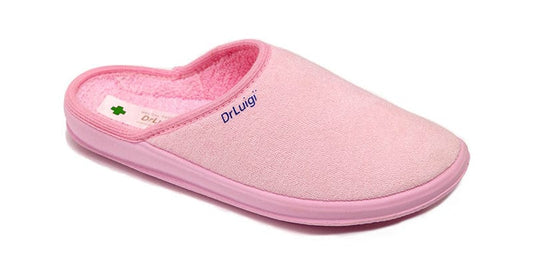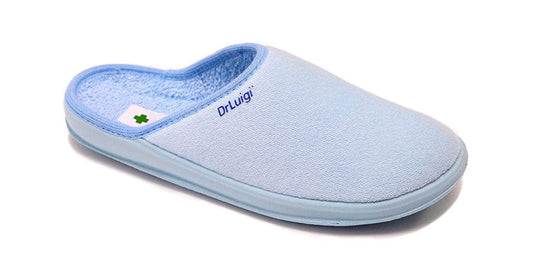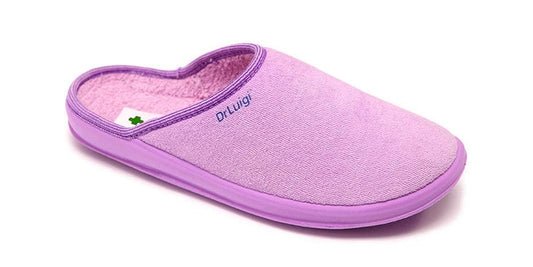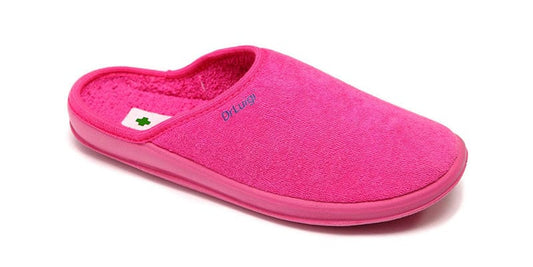The complex structure of the feet is an evolutionary marvel. The foot is a dynamic system for movement, and at the same time a support for the body’s weight. Although the foot itself has a small surface area, it contains 25% of all the bones in the body. In addition to numerous bones, it contains 33 joints, numerous tendons, fascia, ligaments and more sweat glands than any other part of the body. Many foot issues can be side-steped with the right choice of footwear, DrLuigi’s medical footwear is highly recommended for a comfortable and healthy gait. (www.drluigi.eu) .
Athlete's foot - a contagious fungal infection that leads to severe itching and excoriation of the feet. The infection is caused by fungi such as Epidermophyton floccosum, Trichophyton rubrum sensu stricto and Trichophyton interdigitale. This disease is also called tinea pedis. The infection is most often transmitted in humid areas, such as swimming pools or walking on wet floors. Infected shoes are also an ideal medium for transmitting the disease. When walking on the floor, a person becomes infected due to the infectious scales they come in contact with. The disease got the name athlete's foot because it is the athletes who are the most affected group due to the long-term wearing of closed shoes. There are 3 types of athlete's foot: the inflammatory type, moccasin type and interdigital. The moccasin type mostly affects the soles, the interdigital area between the toes, and the inflammatory one can affect the entire foot. The inflammatory type can also manifest as extensive inflammation with blistering, excoriation (peeling, scratching of the skin), dandruff… In addition to these changes, itching, redness, and thickening of the skin occurs… If the changes affect the toenails, then they become brittle and change color to a cloudy white-yellow, and in addition spread a very unpleasant odor. The feet are not the only place on the body that an infection can affect. The groin and arms can also be affected. Treatment of athlete's foot includes symptomatic measures, which are in principle prevention and treatment with antifungals (antifungal drugs). Preventive, i.e. symptomatic measures are keeping the feet dry, changing socks regularly, using cotton socks, avoiding tight plastic shoes… Especially avoid barefoot walking on damp and unwashed floors, which are often a source of infection. Antifungal drugs, clotrimazole, miconazole, tolnaftate are used as a treatment. Treatment is often long-term and the patient should be very persisten
Blisters - small bubbles filled with fluid caused by the rubbing of the skin. They occur as a reaction to skin trauma, which is most often in the place where the shoes cause a lot of friction. The cause of most blisters are too small and inadequate shoes. Although they are relatively benign, they can cause major problems. The blisters should in principle not be touched and punctured but only covered with a band-aid until they shrink and harden. If the blister is in a very inconvenient place, then it can be punctured, but care must be taken. It is necessary to disinfect the skin and pierce a small area with a needle, without removing the surrounding skin. In this way, the infection that occurs by removing the upper skin is prevented. After drilling the blister, keep the area as clean as possible and disinfect it regularly with alcohol or a similar disinfectant.
Ingrown toenails - a very common problem especially in women. 20% of people will encounter this problem during their lifetime, and the condition itself is manifested by ingrown nails in the surrounding skin and flesh. An ingrown toenail usually occurs on the big toe, and is caused by improper footwear and an improper way of cutting the nail. The nails should never be rounded during a pedicure, but the upper edge of the nail plate should remain flat. Symptoms of an ingrown toenail are: pain, redness of the surrounding tissue, swelling of the flesh around the nail, and sometimes a tissue infection that can be very painful. Surgical treatment is often the last option in case of infection. Fortunately, prevention is very simple in the case of an ingrown nail. Footwear with a very high heel and footwear with a pointed front should be avoided. Footwear with a pointed front part narrows the foot and pushes the nails and toes forward, which helps the nail to grow into the flesh.
Fungal nail infections - Most nail infections start as a foot infection that spreads. The fungi that cause the infection are: Trichophyton rubrum, Epidermophyton floccosum… An infected nail is easily recognized. The nail becomes white, thickens, becomes brittle, and can also flake off. Treatment used to be carried out by taking systemic antifungals, but the protocol has now changed. Long-term use of antifungals has had many side effects, and combination therapy is now recommended. The drugs used today are: terbinafine, itraconazole, fluconazole. In addition to oral therapy, laser is also combined. Regardless of advances in treatment, the road to complete cure can be a long one, especially for vulnerable groups. Vulnerable groups include athletes, people with diabetes, the elderly with poor circulation, immunocompromised people… As with athlete's foot, the most important thing is to prevent infection. We do this by regular foot hygiene and by avoiding wearing shoes that are made of synthetic material and are tight for a long time.
Corns - Corns should primarily be distinguished from calluses. The calluses are thickening of the soles at the site of the greatest load, they look hard, but they are not painful to the touch. Corns, on the other hand, are painful to touch. In addition, these two conditions differ in that the cornea is raised like a lump, and is most often on the toes. Men are more often affected by this phenomenon, and the mitigating circumstance is that corn is an almost completely harmless phenomenon. The main cause is the constant rubbing of the skin that can occur due to: long standing, diabetes, uncomfortable shoes, not wearing socks, extremely high arch of the foot… When wearing shoes that are too narrow, corns appear between the toes. Due to prolonged friction and excessive sweating, the skin thickens, becomes yellowish and corns appear. Treatment is often possible at home with: stone float, long-term soaking of the feet in the customer, manicure scissors… There are also patches on the market to combat corn. If you can't get rid of corn on your own, be sure to visit a medical pedicurist, especially if you suffer from diabetes so as not to create deeper ulcers that will be difficult to heal.
Plantar fasciitis - soreness of the lower part of the heel bone that occurs as a result of overexertion. Overuse injury causes micro-damage that eventually leads to degeneration of the plantar fascia. The plantar fascia clings to the heel bone and reaches all the way to the initial joints of the fingers. The fascia itself is divided into middle, medial and lateral parts. The middle part is the most important part of the fascia and is most often prone to injury. The causes of fasciitis are divided into external and internal. External causes include footwear with a hard and inflexible bottom, worn out footwear, changes in training intensity and running on uneven terrain. Internal causes include foot deformities such as sunken foot (pes cavus), lowered feet, valgus position of the heel… Excessive pronation (rotation of the foot inwards, i.e. towards the middle of the body) also leads to plantar fasciitis. In addition to these causes, obesity is a risk factor. In athletes, long-distance runners are most exposed to fasciitis. Fasciitis usually occurs between the ages of 40 and 60, and occurs equally in both sexes. Fortunately, fasciitis is unilateral in 85% of cases. The first symptom is pain at the starting point of the fascia, i.e. on the heel bone. The pain usually occurs in the morning when getting up, and disappears with stretching and movement. Pain described as a "nail in the heel" is often reported. Treatment of plantar fasciitis includes physical therapy, surgical treatment, and wearing a splint… Surgical treatment involves fasciotomy, i.e. relaxation of the fascia, which can be done endoscopically with minimal trauma to the surrounding tissue. Physical therapy is carried out through a combination of exercises, ultrasound therapy, cryotherapy… Recently, doctors have recommended wearing night splints. Night splints look like shin splints or orthoses that hold the foot at a right angle to the shin. Such a position is beneficial since during the night the foot is directed downwards and consequently the plantar fascia is shortened. With the help of a splint, morning pains are absent due to the neutral position of the feet.
Gout - inflammation of the joints (arthritis) that occurs due to pathological metabolism of uric acid. Uric acid is a byproduct of purine breakdown (purines are an integral part of DNA). In a healthy person, uric acid is broken down in the blood or excreted in the urine. If the production of uric acid in the body increases or, for example, too much purine is ingested through the diet, then the acid crystals are deposited in the joints. In some cases, uric acid deposition is asymptomatic. Gout is 20 times more common in men, and the most affected age group is the one from 40 to 50 years of age. Recognizable symptoms of gout are: redness of the joint (usually the big toe), severe pain, tenderness, heat… In addition to the big toe, the knee joint, elbow, and toes can also be affected… There is no cure for gout in principle, but with many therapeutic options , it can be kept under control. Non-steroidal anti-inflammatory drugs (paracetamol, indomethacin) are used to reduce pain and inflammation, and allopurinol is used. Pharmacotherapy is not the only way to keep the disease under control. A lifestyle change can also have an impact. In earlier times, gout was considered a disease of kings because only very rich people could afford foods rich in purines. These foods are: bacon, beef, anchovies, pheasant, salmon, sausages, brain, turkey, veal, venison… Alcohol is not rich in purines, but interferes with the excretion of uric acid and should be avoided. Today, gout is no longer a disease of "kings" but people who have a genetic predisposition. However, this does not mean that general prevention measures should not be adhered to, as excessive consumption of meat and meat products certainly contributes to the disease.
Digitus flexus and digitus malleus - digitus flexus, i.e. the classic curled toe and digitus malleus or hammer toe, are common foot deformities. They follow the hallux valgus in frequency. With a curled toe above the wrist, redness and swelling occur, which is aided by the pressure of the shoes. Likewise, digitus flexus can gradually dislocate the base of the finger joint. Digitus malleus differs from digitus flexus by the site of deformation. While the hammer finger has a deformed junction of the middle and distal phalanges, with a curled finger the deformation is located at the junction of the middle and proximal phalanges. Treatment is usually surgical and it brings lasting results. After the operation, the patients were not immobilized and the recovery was relatively quick.
Hallux valgus - a bony growth of the base of the big toe. In translation, this disease is called the "devil's bone", and judging by the problems it can cause, the name of this disease is justified. Valgus is the most common deformity of the foot, and is generally considered to be the most common deformity of the skeletal system in humans. The toe bends to the side and the front of the foot narrows. Modern footwear contributes to the creation of hallux valgus. High-heeled shoes create a heavy load on the front of the foot. This load is particularly high if a person stands or walks for a long time in such footwear. In doing so, the longitudinal part of the foot collapses, the front part of the foot should expand like a fan, and since this is not possible in tight footwear, deformations occur. The fingers clump together, and the thumb deforms and bends to the side. Muscles and connective tissue also weaken due to reduced foot mobility in tight footwear. The combination of collapse of the arch of the foot, weak muscles and surrounding structures creates a deformation of the I. metatarsal bone. Hallux valgus affects women far more often, this condition is 9 times more common in women. Changes begin as early as adolescence, and the onset of pathological changes is accelerated by inappropriate footwear. The age group of 50 to 70 years most often go to the doctor because of issues with bunions. Inflammation of the bursa at the site of the protrusion of the head of the metatarsal bone is also a common problem. Then the medial side of the thumb looks swollen, painful to the touch of that changed color. Milder deformities can be alleviated by choosing the right footwear. Wider shoes without a raised heel are recommended. In addition, the shoe must be pliable and flexible to follow the movements of the foot muscles. Unfortunately, such footwear usually does not follow fashion trends, so it is difficult to reach the younger population where prevention would make the most sense. If the problems become very pronounced, then the only thing left is surgical treatment. There are more than 150 types of procedures used in straightening the hips, and their goal is to correct the position of the thumb.
Morton's neuroma - this unpleasant syndrome is actually a thickening and inflammation of the nerve and surrounding anatomical structures located between III. and IV. metatarsal bones. Morton's neuroma is caused by excessive and prolonged stretching of the toes, for example when wearing high heels for a long time. Excessive stress in the tissue and nerve creates inflammation and consequent thickening of structures in the metatarsal tunnel. Stretching of the metatarsal tunnel creates pain, and pain most often occurs in the front part of the foot under the toes. Pain occurs during activities, especially running, and in some cases can prevent normal walking. Treatment is most often symptomatic. Physical therapy is recommended and it is not recommended to wear narrow shoes and shoes with high heels. Instead, patients should wear comfortable wider shoes with an orthopedic insole containing metatarsal pads that prevent the toes from stretching. The pads are combined with analgesics (ibuprofen, paracetamol…). The most used techniques in rehabilitation are cryotherapy and ultrasound treatment. Cryotherapy cools the painful parts to alleviate the discomfort. In severe cases, surgical treatment is unavoidable and consists of removing the thickened structures.





